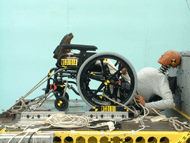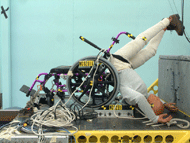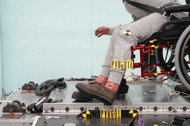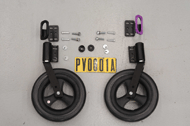Crashworthiness of Forward-Facing Wheelchairs under Rear Impact Conditions
Miriam A. Manary1, Beth A. Bezaire1, Gina E. Bertocci2, Zdravko Salipur2, and Lawrence W. Schneider1
1University of Michigan Transportation Research Institute, 2University of Louisville
ABSTRACT
Current voluntary wheelchair standards address crashworthiness for wheelchairs used as seats in motor vehicles under frontal impact conditions. A new standards development effort addresses the crash performance of forward-facing wheelchairs in a moderate-severity, rear-impact crash. Dynamic sled tests were conducted using nine commercial manual wheelchairs to evaluate rear-impact crashworthiness based on the preliminary performance criteria. The results of the dynamic tests show structural failures occurred in all wheelchairs tested. The failures observed include detachments of the wheelchair seatback and fracture of wheelchair components such as the seatback canes, wheelchair frame members, or front securement points. This information will be useful to wheelchair manufacturers seeking to design wheelchairs for improved rear-impact performance and will help inform the standards effort.
KEYWORDS
Wheelchairs, transportation, crash safety, rear impact, seatback strength
BACKGROUND
ANSI/RESNA WC19 Wheelchairs for Use in Motor Vehicles (WC19) establishes design and performance requirements and associated test methods to evaluate the frontal crash performance of occupied, forward-facing wheelchairs using a 48-kph, 20-g vehicle crash pulse (1). In developing this wheelchair transportation safety standard, frontal-impact protection was recognized as the first safety priority because national data show that more that half of all fatal and disabling injuries to occupants of motor vehicles occur in frontal collisions (2). Now that this standard has been in place for more than five years and most wheelchair manufacturers are designing and testing products to comply with the standard, efforts have begun to expand the crashworthiness of wheelchairs to rear impacts.
A proposed voluntary wheelchair standard for forward-facing wheelchairs in rear-impact loading (hereafter referred to as the draft FFRI standard), establishes test methods and performance requirements using a rear-impact crash pulse of 25-km/h (15.6 mph) and 14-g (3). This pulse is representative of a moderate-severity rear-impact crash for a passenger vehicle such as a minivan. While vehicle seat performance is important to occupant protection in frontal impact crashes, it is even more critical in rear-impact crashes where the seatback provides the primary restraint for the occupant (4). As with WC19, the draft FFRI standard is primarily a dynamic strength test for the wheelchair under this loading mode. The proposed performance requirements focus on the structural integrity of the wheelchair and its ability to provide a safe, stable, and supportive seating position for the wheelchair user throughout the impact event. Recommendations for the height of the seatback and the position and presence of a headrest are included in the standard in an informative annex, but are not current design requirements. However, these features have the potential to improve occupant protection in rear impact crashes.
OBJECTIVES
The objectives of this study were to determine the performance of forward-facing commercial wheelchairs used as seats in motor vehicles when subjected to the proposed rear-impact test conditions and to gain experience with the test methods and performance criteria set forth in the draft FFRI standard. The data and the experience gained from performing the tests will be used to advise wheelchair manufacturers and refine the proposed rear-impact standard.
METHODS

 Figure 1. Typical wheelchair responses to seatback loads incurred during rear-impact crash tests. (Click image for larger view)
Figure 1. Typical wheelchair responses to seatback loads incurred during rear-impact crash tests. (Click image for larger view) Nine rear-impact sled tests were conducted using a 25-32 km/h (15.6-20 mph) and 12-14 g rear-impact crash pulse. A Hybrid III midsize-male anthropomorphic test device (ATD) with mass of 77.1 kg (170 lb) was used in all tests except one, where a weighted small-female ATD with mass of 59 kg (130 lb) represented the wheelchair occupant. The wheelchairs used for testing were all commercial manual wheelchairs that have been successfully tested to WC19, some with folding frames and some with rigid frames.
For each test, the wheelchair was secured on the sled platform using a four-point, strap-type tiedown, as specified in Annex A of WC19, and the ATD was restrained by either a surrogate, vehicle-anchored three-point belt or a two-point pelvic belt. Two side-view high-speed video cameras were used to document wheelchair and ATD excursions and kinematics during each test. Upon completion of each test, the wheelchair and ATD positions were inspected and photographed. Analysis of the high-speed digital video and the post-test inspection were used to determine whether the wheelchair complied with the design and performance criteria of the draft FFRI standard, listed in the first column of Table 1.
RESULTS
Table 1 summarizes the results for the nine sled tests and indicates the number of wheelchairs that complied with each of the proposed performance criteria. In 78% of the tests, there was visible failure of primary load-carrying components. Since the seatback is the primary occupant restraint in rear impacts, this is the component that failed most often. Figure 1 shows typical post-test conditions of wheelchairs with seatback failures where the ATD is no longer supported in a seated position. The prevalent form of failure was fracture and/or bending of the seatback posts, which led to failing of additional performance criteria. For example, in more than half of the tests, the seatback angle did not comply with maximum allowed recline angle during and/or after the test due either to bending or failure of seatback posts. In over three-quarters of the tests, the crash dummy was not in an upright seated position at the end of the test, as indicated by the torso angle being reclined more than 45 degrees to the vertical. In many of these cases, the seatback failed and the ATD fell onto the sled platform. Correspondingly, almost half of the tests exceeded the limit for ATD H-point height decrease between pre-and post-test height measures. Sharp edges were prominent in the occupant area, usually due to structural failures. These results demonstrate the need for stronger wheelchair seatbacks, more robust seatback attachment hardware, and strengthening of the seatback-to-seat-frame junction.
|
Number of Wheelchairs |
||
|---|---|---|---|
Performance Criteria |
Did not meet criteria |
Met criteria |
Not Applicable |
During the test |
|||
Meets P-point horizontal excursion limits |
1 |
7 |
1 |
Meets ATD rear of head horizontal excursion limits |
8 |
0 |
1 |
Peak dynamic seatback angle is less than 65° to vertical |
5 |
3 |
1 |
After the test |
|||
Wheelchair [base] is in upright position |
1 |
8 |
0 |
ATD is in seated position in wheelchair |
7 |
2 |
0 |
No visible failure at securement points |
3 |
5 |
1 |
No parts with mass greater than 100 g completely separated from wheelchair |
2 |
7 |
0 |
No sharp edges that may contact occupant |
7 |
2 |
0 |
No visible failure on primary load-carrying components |
7 |
2 |
0 |
No tools required to remove ATD from wheelchair |
0 |
9 |
0 |
No tools required to release wheelchair from tiedown system |
0 |
9 |
0 |
Post-test seatback angle is less than 45° from vertical |
6 |
3 |
0 |
H-point height decrease is less than 20% |
4 |
5 |
0 |

 Figure 2. Illustration of detached front wheelchair securement points. (Click image for larger view)
Figure 2. Illustration of detached front wheelchair securement points. (Click image for larger view) A second important issue highlighted by these data is failures of the front securement points, which are loaded more severely in the rear-impact tests than during wheelchair rebound in the 48 km/h (30 mph) frontal impact test of WC19. The front securement points of one- third of the wheelchairs failed either by material failure or by deformation that restricted removal of the tiedown hook. Some typical results are shown in Figure 2. In some cases these failures allowed the wheelchairs to shift or translate along the sled platform, creating an environment where the wheelchair is not able to provide a supportive, and stable seat for the rider. Additionally, material failure of securement points created sharp edges and/or rigid masses of more than 100 g (3.5 oz) that became separated from the wheelchair with the potential to injure other occupants.
The design and dimensions of the seatback and design or even presence of a rear head restraint will likely only be recommended and not required by the FFRI standard. Nonetheless, it is useful to note these features on the wheelchairs tested in relation to results obtained. Only two of the nine wheelchairs included a head restraint and one of these did not meet the recommended height. The allowed limit for peak horizontal head excursion was exceeded in all tests, including the test of the wheelchair with a head restraint of sufficient height. This suggests that head rests/supports present on wheelchairs are not designed to provide rear impact protection and may not be effective to this end.
DISCUSSION AND CONCLUSIONS
The series of crash tests show that wheelchairs that meet the frontal impact crashworthiness requirements of WC19 are not likely to provide effective restraint for their occupants in moderate-to-severe rear impacts. The current investigation of wheelchair failure modes under rear-impact crash conditions has identified two main aspects for improving occupant safety in WC19-compliant wheelchairs. First, and most importantly, the wheelchair seatback must be designed to better withstand the occupant loads imposed by acceleration of the vehicle, especially the seatback posts and attachment hardware. Second, front wheelchair securement points need to be made stronger than they are for frontal impact testing. In addition, wheelchair and wheelchair seating manufacturers should consider designing seatbacks and including rear head restraints that will improve occupant support and containment in rear impacts.
REFERENCES
- ANSI/RESNA Subcommittee on Wheelchairs and Transportation (2000). ANSI/RESNA WC/Vol.1, Section 19:Wheelchair Used as Seat in Motor Vehicles.
- National Highway Traffic Safety Administration (2001) Traffic Safety Facts 2001, US Department of Transportation, Washington, D.C.
- ISO WG6, PWI Technical systems and aids for disabled or handicapped persons – Wheelchairs – Forward facing wheeled mobility aids in rear impact Working draft version 2007-1-9.
- Manary, MA and Schneider LW, Wheelchair Seatback Loads and Deflections in Rear Impacts. RESNA 2004, Orlando, FL.
ACKNOWLEDGEMENTS
This study was funded by the National Institute on Disability and Rehabilitation Research (NIDRR) and the Rehabilitation Engineering Research Center (RERC) on Wheelchair Transportation, grant # H133E060064. A portion of the data originated in testing sponsored by the Paralyzed Veterans of America (PVA). The ideas and opinions expressed herein are those of the authors and are not necessarily reflective of the NIDRR or PVA. The authors would like to thank Brian Eby, Stewart Simonett, Nichole Ritchie, and Charles Bradley for their assistance conducting the dynamic tests.
Miriam A. Manary, MSE
University of Michigan Transportation Research Institute
2901 Baxter Road, Ann Arbor, MI 48109
mmanary@umich.edu
Highlights
- Source Ordered
- No Tables
- Very Compatible
Gargoyles
Disney produced a television show in the mid 1990s called Gargoyles. It's a great show and I'm a big fan. A few years ago Disney started to release the show on DVD. The last release was of season 2, volume 1. That was two years ago. Volume 2 has not been released. Why? Poor sales. So if you should find yourself wanting to support my work, instead I ask you pick up a copy of season 2, volume 1. It's a great show and you might find yourself enjoying it.